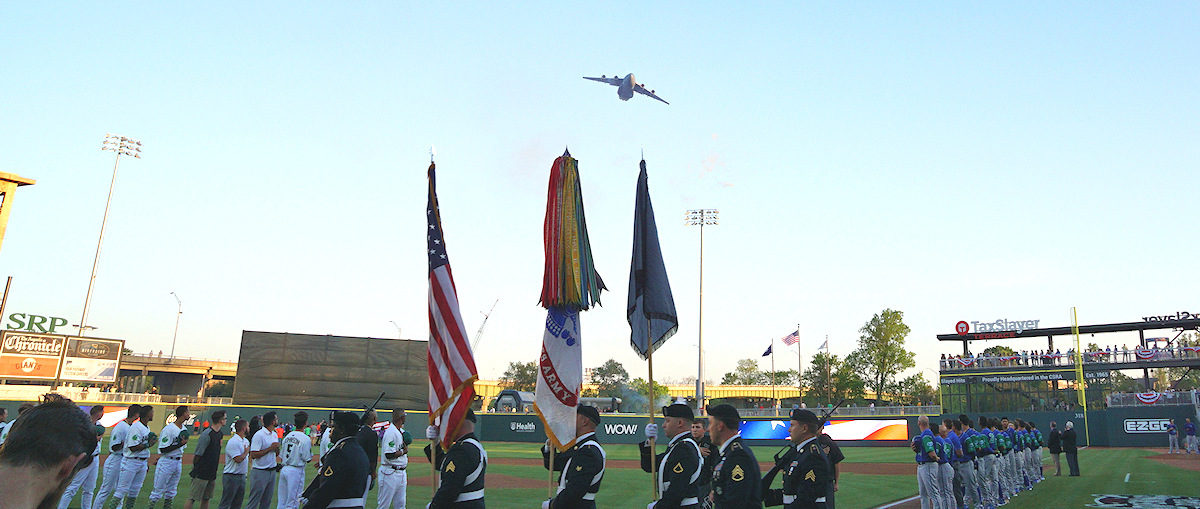Article and photos by Joe Mock, BaseballParks.com
All rights reserved
When Nolan Ryan’s investment group was looking to move their Texas League franchise to Central Texas in the late 1990s, they targeted Austin as the desired landing spot. After all, it was the largest metro area in the country with no Major League or affiliated Minor League team. After quite a bit of politicking by the “no welfare for millionaires” crowd, Austin declined to build a new stadium for the team.
| Ballpark Stats |
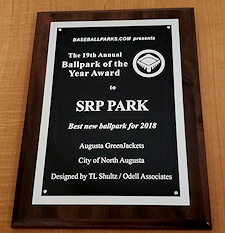 |
| Award: 2018 BaseballParks.com Ballpark of the Year. See press release here. |
| Team: Augusta GreenJackets of the South Atlantic League |
| First game: April 12, 2018, a 6-5 loss to Lexington |
| Capacity: 4,530, including 3,530 fixed seats |
| Dimensions: LF – 330; CF – 395; RF – 318 |
| Architect: Odell and TL Shultz | ISC |
| Construction: Brasfield & Gorrie |
| Price: $42 million |
| Home dugout: 3B side |
| Field points: Southeast |
| Playing surface: Tifway 419 Bermuda overseeded with rye |
| Ticket info: greenjacketsbaseball.com or call (706) 736-7889 |
| Betcha didn’t know: The park sits on the exact spot of a South Carolina Dispensary. From 1893 to 1907, these were the only places where liquor could be bottled and sold in the state. |
Ryan then looked to the northern suburbs for assistance. The ownership group found it in spades in Round Rock, which pulled off a land swap to facilitate the construction of the Dell Diamond in 2000, 22 miles north of downtown Austin. The Round Rock Express went on to break the all-time Double-A attendance record for five straight seasons.
The Arkansas Travelers desperately wanted a new ballpark to replace aging Ray Winder Field. When plan after plan for a new ballpark in Little Rock, Arkansas fell apart, the suburb of North Little Rock came through with Dickey-Stephens Park, a $40-million facility that won our 2007 Ballpark of the Year Award.
Throughout the first decade of the 21st Century, the Charlotte Knights wanted a new home to replace sterile Knights Stadium. The park was so far south of Charlotte that it was across the state line in South Carolina. Finally, the City of Charlotte helped make BB&T Ballpark a reality in 2014. It’s located in the heart of the city, 15 miles north of their former home.
When the Ripken Baseball group, owners of the Augusta GreenJackets, determined they needed a new ballpark, they understandably commenced talks with the City of Augusta. After four years of agonizing back and forth bore no fruit, a developer and the City of North Augusta came to the franchise’s rescue. They made a new ballpark the focal point of a mixed-use development on the northern shore of the Savannah River, just across from Augusta.
Do you see a northward pattern here?
The GreenJackets now have the new home they’ve been seeking, and it took a community to the north of their previous park to make it happen.
Let’s take a closer look at the twists and turns from Lake Olmstead Stadium, the team’s home for 23 seasons, to SRP Park.
“You could write a book on it,” says Jeff Eiseman, Principal/President of Agon Sports & Entertainment, which now owns and operates the franchise. “It really did take an iron will to get this across the finish line.”
Here’s the story. Ripken Baseball had taken ownership of the GreenJackets in 2006, with Eiseman overseeing the operations. He describes Lake Olmstead Stadium, the team’s home since 1995, as being a “charming ballpark in its time. But operationally, it was miserable. We had so many problems operating that building. We realized that it was going to cost so much to improve it that it wasn’t worth the investment.”
In 2007, with the economy starting to take a nosedive, discussions began with the City of Augusta on a new riverfront ballpark. Jacoby Development was part of the negotiations because they wanted to create a private-public partnership on a mixed-use development, with the new park as its cornerstone. Several years of discussions led to nothing but disagreements among the city’s commissioners. While everyone seemed to agree that such a development made sense, it seemed that each commissioner was only willing to support it if it were to be built in his/her district.
| By the lake |
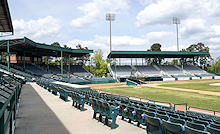 |
| Lake Olmstead Stadium, shown above as it looked as the the GreenJackets moved into SRP Park, was the team’s home for 23 seasons. The lake itself (shown below with the stadium’s lights in the background) is fed by one of the most famous creeks in the world. Rae’s Creek, you see, flows through the Amen Corner of the Augusta National golf course only a mile away. The team nickname of GreenJackets, of course, is due to the nearby Masters Tournament. |
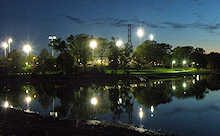 |
The folks at Jacoby then turned their attention across the Savannah River to North Augusta, with the concept of including a new park still part of the plan. Cal Ripken, though, had already endured years of disappointments regarding a new stadium, and since North Augusta was definitely not a sure thing, he opted to sell his interests in the franchise to Agon. The sale was facilitated by Eiseman, but it wouldn’t have possible without the involvement and investment by Chris Schoen of Greenstone Properties.
A basic agreement was struck between the team, Jacoby and the City of North Augusta on 35 marshy acres in 2011. Soon thereafter, a private citizen of North Augusta named Steve Donahue filed a lawsuit challenging the City’s proposed financing package. “The entire court process took about 18 months,” recalls Todd Glover, the City Administrator for North Augusta. “However, I would say the delay (to the project) was much longer in that private businesses were not willing to invest money into design and land because of the uncertainty of the court case.
“Once the ruling by the State Supreme Court came down (in June 2015), it was almost like we had to start over,” he added. Businesses such as restaurants and hotels that couldn’t continually push back the deliverable date had dropped out of the discussions.
Eiseman pointed out another impact on the ballpark. “The delay affected the construction cost, so we had to go through and figure out what could be modified to bring the cost down to still deliver the kind of ballpark that we all wanted.”
Meanwhile, Jacoby had recommended that Greenstone Properties become involved in the planning as Jacoby was mired in major projects elsewhere. As the development gained steam, Greenstone moved to the front and became Master Developer of the project, just as Eiseman and Agon took control of the team. Greenstone’s Schoen assumed the title of Chief Operating Officer of the GreenJackets.”None of this happens without Chris,” noted Eiseman. “He was instrumental to the purchase of the team, the purchase of the land and 100% of the development.”
Changes were also afoot in the name of the development. Its original name was Project Jackson, named for James U. Jackson, who’s credited as being the founder of the City of North Augusta when he constructed a luxurious hotel across the river from Augusta in 1902.
Jackson’s name wasn’t the problem with what to call the development. “The word ‘Project’ denoted that it was still being planned,” Eiseman points out. “We played around with a lot of different names, but in the end, the development’s coolest feature is the river, so we went with Riverside Village.
“Nowhere in this whole area was there a place where the public could congregate along the river,” Eiseman added. Now there is, and it’s called SRP Park. It opened April 12, 2018. Among the special events that evening was a fly-over by a military jet from the Charleston (SC) Air Force Base (photo at the top of this page).
So let’s take a look at the new park’s surroundings and then get into its architecture and amenities. We think you’ll see why SRP Park is our Ballpark of the Year!
The Setting
Like in Charlotte, the GreenJackets’ move involved crossing a state line. That’s because North Augusta — a separate city from Augusta – is in Aiken County in South Carolina, while Augusta is in Georgia.
Was there any thought of changing the team’s name to the North Augusta GreenJackets? “I think most people realize that the ‘green jacket’ is synonymous with Augusta (due to the Masters golf tournament) and the play on words doesn’t work if it is North Augusta,” Glover pointed out. Eiseman adds that “there are certain sensibilities among the different localities here. But one thing is definite: if Augusta catches a cold, the rest of the area gets pneumonia. Augusta is the largest part of the entire market, so there will be no ‘North’ added to the team’s moniker.”
| Proving the point |
 |
| Jeff Eiseman, President of the company that owns the team, asserts that fans on the South Carolina side didn’t come to Lake Olmstead Stadium much, but are really showing up now at SRP Park. As if to prove the point, I met John Travis and his wife of 27 years, Tammy (pictured above on the TaxSlayer Terrace). They live in Aiken, SC. In past years, they attended “maybe three games a year” but now they’ve gone in with friends to buy full season tickets at $750 per seat. “This feels like a Major League park,” he said of the new facility. “We like it being on the river and having a restaurant on site. It’s also a little safer than the Lake Olmstead neighborhood.” |
Does moving from Georgia to South Carolina have any impact on the franchise? “It helped us tremendously,” responds Eiseman. “Had we been going the other way, it would’ve been tougher for us. That’s because South Carolina folks are very provincial and very proud. If there’s something they want to do and they can do it without crossing state lines, they’ll do it in SC.”
He added that while operating in Augusta, “we saw very little of our fan base come from Aiken County (South Carolina). Now that we’re moving to that side, Aiken County is making up a much bigger part of our fan base, and it’s growing every day.”
Another aspect of the team’s move brings to light a surprising development. “With the GreenJackets moving across the state line, Georgia will be down to only two affiliated franchises,” observed Georgia resident Graham Knight, webmaster of BaseballPilgrimages.com. “Today only the Rome Braves and Gwinnett Stripers play in the Peach State. We used to have Minor League teams in Macon, Columbus, Albany, Savannah and Augusta. I’m not claiming there’s a conspiracy but the exodus is kind of odd.”
There’s no exodus from the upscale neighborhood called Hammonds Ferry that is just upstream from the development that includes the ballpark. You sometimes see the 35-acre area called Riverside Village at Hammonds Ferry.
The southeast edge of the development is the overpass that connects the 13th Street Bridge that crosses the Savannah River to Georgia Avenue, which is also U.S. Business Route 25. It runs north into the main part of North Augusta. A golf course and small townhouse community rest just to the southeast of the overpass.
The southwestern edge of the property is (obviously) the river, but unlike Dickey-Stephens Park in North Little Rock, there’s no skyline on the other bank. That’s because Augusta’s business district is about a mile downstream. Instead, stately homes are perched on a levy across from the ballpark.
The northeastern edge of Riverside Village is quite interesting – and not what you’d expect. Brick Pond Park is a 40-acre city park, full of ponds, trails and carefully managed wetlands. Wildlife is abundant – including an occasional alligator – as are mosquitoes and other flying insects (I certainly doused myself with Off before venturing into its system of trails).
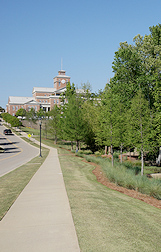 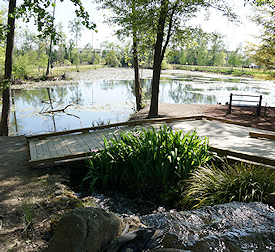 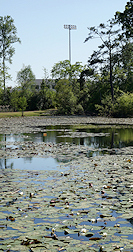 |
| On the left is the North Augusta Municipal Building as you look up Center Street. The other two shot are from within Brick Pond Park looking toward the ballpark. |
This park used to be the site of a large brick-making plant – hence its name. All manner of pottery and masonry came from within its walls, but when a massive flood in 1929 inflicted heavy damage on the factory, its owners moved to higher ground. Today it’s a very interesting area, one worth exploring. After applying insect repellent, of course.
In fact, the land that is now the emerging Riverside Village used to be marshy swamps. Several fans I encountered on SRP Park’s opening night remarked to me that they can’t get used to the idea that this spot “isn’t in the swamps” any more.
Center Street bisects Brick Pond Park, and it connects North Augusta’s Municipal Building (up the hill, away from the river) and the ballpark’s main entrance. The city’s building is a beauty, by the way. It looks very impressive as you drive up the hill away from the baseball park, especially at night.
SRP Park – named, by the way, for a local credit union – is the first major tenant to move into its space in Riverside Village. The structure closest to the ballpark is currently under construction. It will be a 180-room Crowne Plaza hotel, which will include 7,000 square feet of conference space.
As you go to the north away from the ballpark, you’ll find condos and storefronts under construction, and a completed parking garage. This is a great spot to use if you drive to a GreenJackets game.
Eventually, there will be more retail and eatery space directly across Railroad Avenue from the ballpark’s main entrance. As the park opened, construction hadn’t started on this space yet.
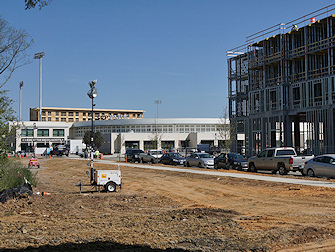  |
| Here you see the under-construction Crowne Plaza on the right with the ballpark in the background. The leveled ground in the foreground will soon contain shops and small eateries. The other image shows a view of Riverside Village from the roof of the park. On the left is the river and on the extreme right is the Crowne Plaza. |
All told, Riverside Village represents about $200 million worth of development. “As a city of less than 25,000, it has been difficult for us to gain traction in attracting retail options, especially restaurants,” Glover explained. “Riverside Village provides for us a destination for people throughout our region and creates a density that is attractive to retail.
“The ballpark has provided an anchor tenant for us that attracts enough people to make the other retail options. In turn, we get the amenities we have always wanted,” he concluded.
The most impressive part of this development is that the buildings that surround the ballpark are actually under construction, not just “envisioned” by the developer. There have been many, many proposals for “ballpark villages” adjacent to new ballparks, but often the park is finished years before any of the other “mixed use” happens. In the case of Busch Stadium in St. Louis, it was almost a decade before Ballpark Village took off. In Glendale and Goodyear, we’re still waiting for it to start.
“I think it mainly shows what a city with vision can accomplish if they stick to that vision,” Glover pointed out. “This project has brought attention to our city that we have never received. While we take pride in our bedroom-community feel, I firmly believe in the old adage ‘if you ain’t growing, you’re dying.’”
The Exterior
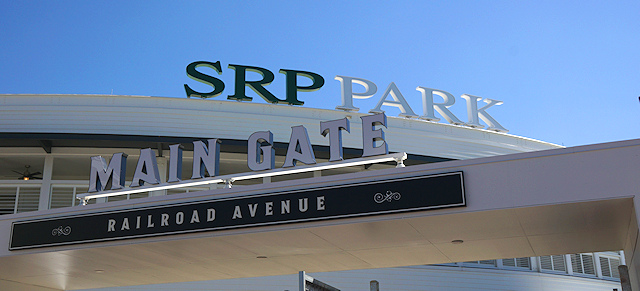
While SRP Park’s exterior closest to the riverfront is basically see-through fencing, the main structures of the ballpark behind third base, first base and home plate are very striking – and not in the usual ballpark way.
It’s instructive to examine the initial thinking of the park’s lead designer. Tad Shultz was the “Planning and Design Lead” for the project. He teamed with the Odell firm, which acted as the Architect of Record and was a strong collaborator on SRP. Odell was also involved in Charlotte’s beautiful BB&T Ballpark. “Coming off of the success of the park in Charlotte, we were thrilled to work on such a dynamic project as SRP Park,” said Mike Woollen, Principal In Charge at Odell. “This has certainly been one of the most impactful projects for community revitalization of my career.”
| Design by Tad |
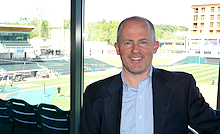 |
| Tad Shultz of TL Shultz | ISC is the Planning and Design Lead on SRP Park. Over 25 years, he’s designed over 60 sports venues for football, basketball, soccer, colleges and of course baseball. Prior to sticking out his own shingle in 2010, he served as Design Director at a number of major sports-architecture firms like HKS and Heery. For SRP, he teamed with Odell, who acted as the Architect of Record. |
In his role as lead designer, Shultz knew from the beginning what the focus of the architecture was going to be. “In our initial meetings, we asked what we can do to make this place special. To us, the site is everything. Unlike a lot of projects where someone bought a cheap parcel of land or a city has property in a ‘transitional’ district, Odell and I were handed an unbelievable, amazing setting.”
Shultz said almost all architectural design begins with what you want the building or buildings to look like before pondering the surrounding walkways and landscaping. “For this project, we did the inverse of that. Ego architecture has you put everything into the buildings and you end up overpowering the site. We didn’t do that. Odell and I wanted the ballpark to be almost subservient to the site.”
He noted that the surroundings — the view across the river, Brick Pond Park, the trees that were going to be saved – had to be “celebrated. And then we worked our way back to the building. So we did things the opposite way that you normally would.”
According to Shultz, in order to make SRP Park “a great place first,” he and Woollen worked with Schoen and the City of North Augusta to conceive the ballpark “as the new living room for North Augusta. We wanted to make the space so great that people would want to come there even when there’s no baseball game.” A new amphitheater and trail along the shoreline that are in the works by the City are aiding this effort.
And then channeling his best Terence Mann from Field Of Dreams, Shultz added, “We made the place so powerful that people will gravitate to it without knowing why.”
And North Augusta’s new living room is one with a tremendous view. “We wanted to be sure that the view corridors of the Savannah were done right.” And as we will see in the next section, there is one particular design element that does a spectacular job of this.
One ambitious goal of the team and its investors was to have a series of storefronts actually built into the first-base side of the ballpark that faces the rest of the development. These retail spaces – which the team refers to as “franchises” – will total 12,000 square feet and will be open to the public whether a game is going on or not. When games are being played, they will serve food and/or drink through large openings that face into the park along the first-base concourse.
Consequently, the main structure of the stadium needed to be on street level, meaning the main concourse inside the park also had to be on street level. This makes SRP Park very different from other ballparks in the Southeast with similar high-water-table issues, like in Pensacola, Palm Beach, Port St. Lucie and Jacksonville. All of these have quite a few steps to lead you from the street up to the main concourse.
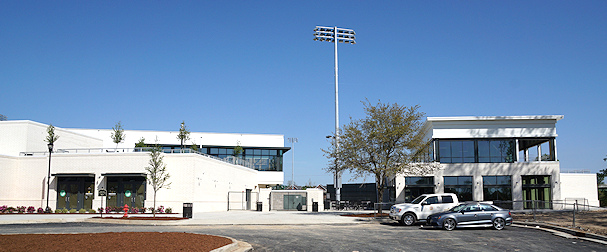 |
| Here we’re looking at the ballpark’s exterior behind first base, with the river to our right. Note the light-colored masonry — very unusual for a baseball stadium — and the structure’s low profile. Toward the left you can see two openings where franchises will open to the street on non-game days. On the right is the two-level Southbound Smokehouse that wasn’t ready for opening day. |
This worked well with another desired aspect for SRP Park. “We also wanted to contextualize the ballpark by reducing its scale,” Shultz explained. “What we didn’t want is for the ballpark to look like a spaceship came and landed onto this spot, like so many stadiums do.” And because the park is one of many buildings in Riverside Village, “we didn’t want the ballpark to dwarf the other components. No, we wanted the park to be a friend to the other buildings on the site.”
And at all costs, Shultz wanted the building materials used in the exterior to emphasize the beautiful surroundings, not compete with them. “We wanted the building to be the canvas and the site to be the painting. We didn’t want to use the same palette (of colors) as all the other ballparks. You see all manner of red bricks over and over and over. We didn’t want that because we wanted the site to be exposed.”
So the predominant look of the chosen materials is light and as natural – and “refined,” according to Shultz – as you can get. After examining dozens of options (because the Mayor and City Council of North Augusta had to grant their approval), “the brick Odell and I chose is a lovely off-white that is both beautiful and museum-quality.” Wrapping the walls of the seating sections is a metal material called Trespa that is strong and looks amazingly like wood. “We wanted to tie in the look of all the trees that are along the Savannah and ring the ballpark with this wood-looking material to make it feel warm.”
If you were to take a walk around the perimeter of SRP Park, you’d be struck by these lighter colors – especially after countless ballparks have tried to replicate the “retro” look that Camden Yards made wildly popular.
You would note the see-through fencing between the outfield concourse and the riverbank, and you couldn’t miss the Tax Slayer Terrace that towers over the area beyond right-field (much more on that later). You’d notice the two-story Southbound Smokehouse restaurant that is the western corner of the park’s footprint.
As you would continue clockwise around the exterior, you’d see the spaces where retail outlets will eventually be housed behind first base. You’ll also see an entryway for those fans with tickets to the upstairs club. The building material used, of course, is the light-colored masonry.
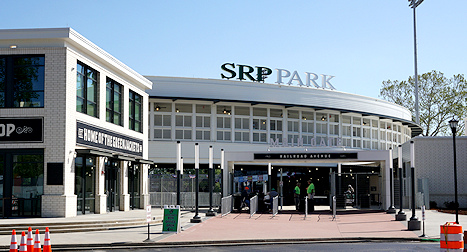 |
| The entry plaza isn’t huge, but it is gorgeous and really shows off the sophisticated — and light — color scheme of the ballpark. |
Behind home plate is the main entry, with a small plaza just outside the gates. From here you can look up and see the hallway that curves behind the upper level suites and press area. Of note are the striking shutters used here. As Shultz points out, these plantation shutters “tie into the Hammonds Ferry neighborhood right down from the site. Again, it gets back to the feeling of a living room.”
To the left of the entry plaza is a door to the souvenir shop so folks can access it on non-game days. The ticket windows are just to the left of the store. Because they are adjacent, there’s even a box-office window inside the store to sell tickets for future GreenJackets games. I don’t think I’ve seen this in a Minor League park before, but it’s an excellent idea.
As you venture down Railroad Avenue toward the overpass for the 13th Street Bridge, things get really interesting. Rising high above the concourse beyond left field is a six-story apartment building. Yes, really. It reminds me of the commercial building beyond left field at Greenville’s Fluor Field or the B&O Warehouse at Camden Yards in the way it is integrated into the ballpark – and in the way it’s impossible not to notice it.
While fans in the stands can’t see it, the bottom level of this building (that was still under construction as the park opened) is for parking for tenants of the apartments. The second level, though, is an enormous space for the two teams’ clubhouses that is on the same level as the ballpark’s concourse.
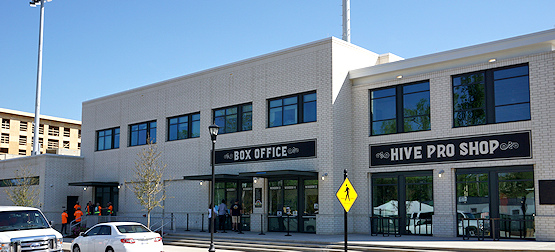 |
| This is the main structure behind third base, just to the left of the entry plaza. The set of windows above the souvenir shop isn’t a separate level. The store has very high ceilings and those upper windows allow a lot of natural light, which is helpful when you’re looking at merchandise. To the left are the ticket windows, and above them are the team offices. On the extreme left of this shot is the top of the six-story apartment building that is adjacent to the left-field concourse inside the park. The clubhouses will be housed in this structure. |
The parent team for the GreenJackets is San Francisco. Yeshayah Goldfarb is the Giants’ VP of Baseball Operations, and he was on hand to check out the facilities on Opening Night. He was kind enough to give me his thoughts on what he found, particularly on the clubhouses: “They will be spacious and comfortable for our players. It’s a place they’ll want to come to every day and be with their teammates and to get better. That’s what we want, and that’s more than we could’ve hoped for at this level.”
The four floors above the concourse will have apartments. Yes, they will have an awesome view of the playing field. If I lived in the Augusta area, I’d want to be in one of these units.
With the apartment building, the massive batter’s eye and all of the trees, motorists don’t really have a great vantage point to see into the park from the bridge. What’s far more relevant, though, is the view that fans inside the park have of the bridge and the river … as we will see when we venture inside SRP Park.
